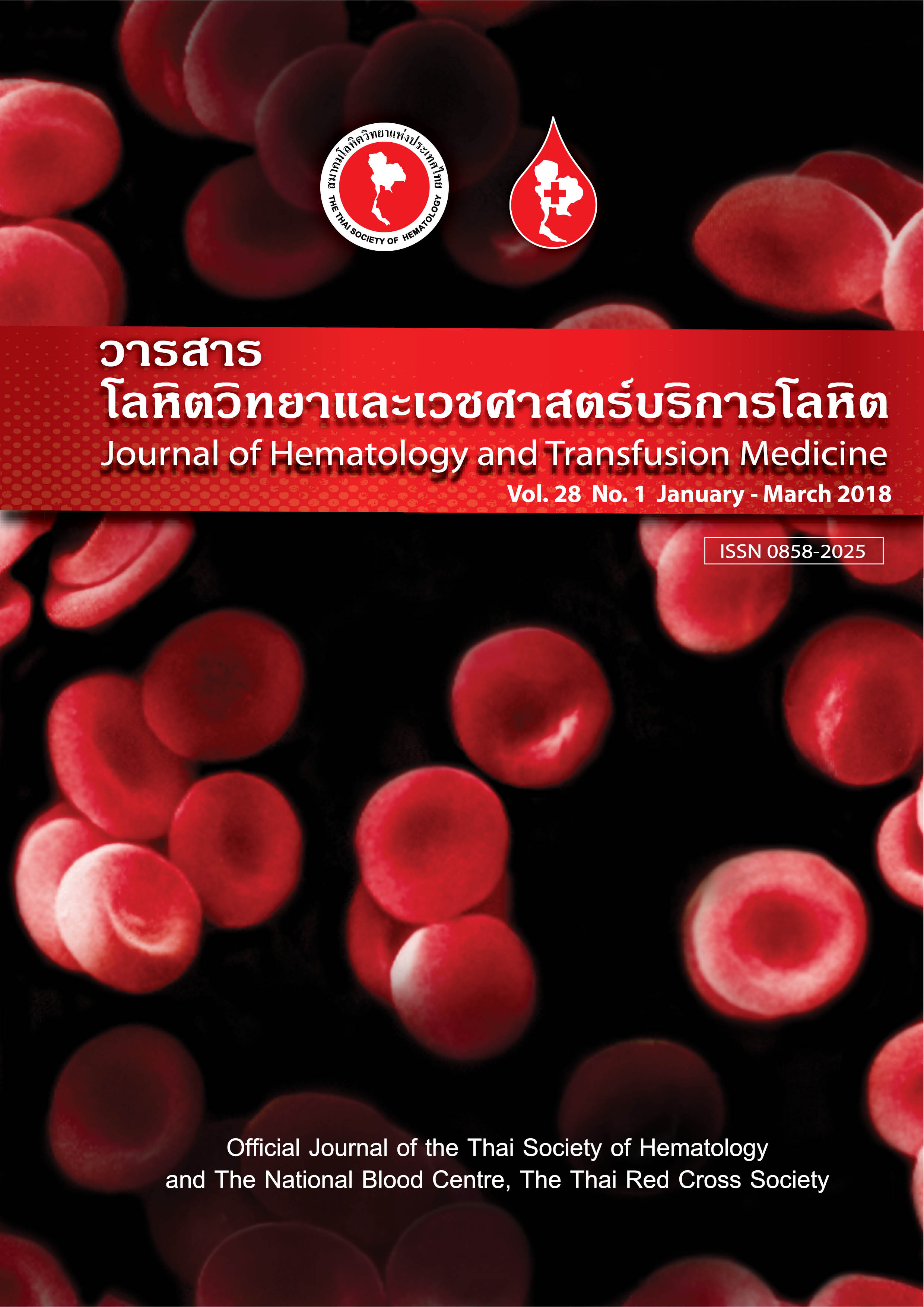การศึกษาแนวทางการเตรียมเลือดที่เหมาะสมสำหรับการผ่าตัดในผู้ป่วยประเภท elective surgery ของโรงพยาบาลกลาง
Keywords:
Elective surgery, Crossmatch-to-transfusion, Transfusion probability, Transfusion index, Type and screenAbstract
บทคัดย่อ
ความเป็นมา ปัจจุบันผู้ป่วยผ่าตัด elective surgery ที่ใช้เลือดมีแนวโน้มเพิ่มขึ้น ทำให้ธนาคารเลือดมีปัญหาในการเตรียมเลือดให้เพียงพอกับความต้องการ จึงควรพัฒนาแนวทางการใช้เลือดที่เหมาะสม โดยใช้ตัวชี้วัด 3 ชนิด คือ crossmatch-to-transfusion (C:T ratio), transfusion probability (%T) และ transfusion index (Ti) วัตถุประสงค์ เพื่อศึกษาการใช้เลือดและแนวทางการเตรียมเลือดที่เหมาะสมสำหรับผู้ป่วยผ่าตัด elective surgery ในโรงพยาบาลกลาง วัสดุและวิธีการ ศึกษาข้อมูลผู้ป่วยผ่าตัด elective surgery ย้อนหลัง 1 ปีโดยเก็บข้อมูลทั่วไปและการสั่งจองเลือดของผู้ป่วย วิเคราะห์ข้อมูลจากดัชนีชี้วัด C:T ratio, %T และ Ti ผลการศึกษา ผู้ป่วยผ่าตัด elective surgery จำนวน 1,645 ราย แพทย์สั่งเตรียมเลือดจำนวน 3,867 ยูนิต แต่มีเพียง 623 ราย ที่ใช้เลือดจริง 1,107 ยูนิต (C:T ratio = 3.5, %T = 42.3, Ti = 0.7) ซึ่งผู้ป่วยผ่าตัดกระดูกและข้อมีการจองเลือดมากที่สุด (C:T ratio = 3.5, %T = 37.9, Ti = 0.7) รองลงมาคือ ผู้ป่วยผ่าตัดสูตินรีเวชกรรม (C:T ratio = 4.4, %T = 14.4, Ti = 0.2) และผู้ป่วยศัลยกรรมทั่วไป (C:T ratio = 2.5, %T = 54.9, Ti = 1.1) เมื่อวิเคราะห์ข้อมูลโดยใช้แนวทางการเตรียมเลือดแบบ type and screen (T&S) พบว่าช่วยประหยัดค่าใช้จ่ายการตรวจ complete crossmatch 414,000 บาท สรุป จากการศึกษาย้อนหลังผู้ป่วยผ่าตัด elective surgery ของโรงพยาบาลกลางมีการสั่งจองเลือดเกินความต้องการใช้จริง จึงควรเลือกใช้แนวทางการสั่งจองเลือดที่มีประสิทธิภาพ เพื่อลดการสูญเสียทรัพยากรและค่าใช้จ่ายที่เกิดจากการเตรียมเลือด ส่งผลให้มีปริมาณเลือดหมุนเวียนและเลือดสำรองคงคลังเพียงพอในกรณีฉุกเฉิน
Abstract:
Background: The number of requests for blood transfusion in patients on the elective surgery is currently expanding, which may be resulted in the shortage of blood supply. The implementation of three-index blood utilization management including crossmatch-to-transfusion (C:T ratio), transfusion probability (%T) and transfusion index (Ti) is suggested. Objective: To study an approach to blood utilization in elective surgery at BMA General Hospital. Material and Methods: A 1-year retrospective data in demographics and blood requests of patients on the elective surgery was collected. Three-index blood utilizations of C:T ratio, %T and Ti were analyzed. Results: There were 1,645 patients on the elective surgery and the total blood requests were 3,867 units. Only 623 patients with 1,107 units were transfused (C:T ratio = 3.5, %T = 42.3, Ti = 0.7). The highest blood requests were patients in Orthopedics (C:T ratio = 3.5, %T = 37.9, Ti = 0.7), followed by patients in Obstetrics and Gynecology C:T ratio = 4.4, %T = 14.4, Ti = 0.2) and patients in General surgery (C:T ratio = 2.5, %T = 54.9, Ti = 1.1). When type and screen were compared with complete crossmatch, the total cost of blood preparation was reduced, 414,000 THB were saved. Conclusion: This retrospective study showed the over blood ordering in elective surgery at BMA General Hospital. The appropriate and effective blood utilization should be used to reduce resources and the cost of blood preparation and to provide flexible utilization of blood stock, especially in emergency situations.



